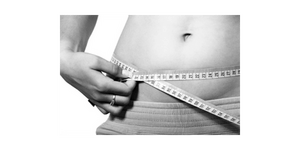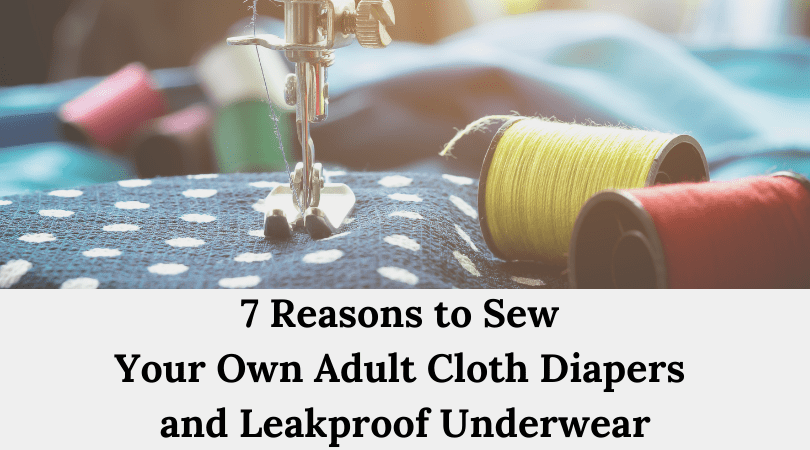If you’re like me, the thought of buying something expensive that you could just make yourself doesn’t make sense. After all, most of the time it’s a lot cheaper to make something yourself and cloth incontinence items are not exception.
At the end of the day, buying disposable adult diapers to manage incontinence puts a burden on the monthly budget, yet the cost of buying cloth can feel completely OUTSIDE the budget.
It’s a lose-lose and either way; you’re still bleeding money because you NEED those products. Luckily, sewing your own adult cloth diapers and leakproof underwear can not only save you money, but comes with a host of other benefits.
1. It’s Easy
Seriously. If you are interested in how to make cloth diapers for adults and you can sew a pillowcase and stitch elastic onto something with a zig zag stitch, you are so golden, you might as well be Midas himself. I know, I know, it looks daunting, especially since adult cloth diapers, training pants, and underwear are not the dainty things that cover baby and toddler butts.
Even sewing with knit fabric doesn’t have to be challenging. Taking your time and using the correct tools will make it a breeze. When you’re done, you’ll wonder why you bothered spending so much money buying other peoples’ products.

2. It’s affordable
If you want really nice organic cloth diapers or pretty patterned leakproof underwear, but can’t afford the crazy cost of them, rest assured that the fabric is merely a fraction of the cost.
For example, I sell my fitted bamboo fleece diaper for $50, though the material costs run around $25. Why do I charge so much? Because they take me around an hour to sew, I pay shipping, and I’m running a business – which means I need to actually make a profit for my time and give Etsy their 10%, lol!
Making your own pair of leakproof underwear can run in the single digits, and while slightly more complex, is still manageable by the intermediate sewer.
PUL diaper covers run around $30, but you can buy a yard of fabric for $10-$20 per yard and make 2-3 diaper covers for that yard. Plus fold over elastic, but that’s only going to put you out a couple more bucks.
You could even sew them WITHOUT fold over elastic. An option that is much harder to find online.
That’s plastic pants cheap, only you get a more eco friendly and durable product.
3. Control over the material in your reusable underwear
Let’s face it, the material choices available in reusable cloth incontinence products are mostly relegated to cotton and microfiber for absorbency and plasticky fabrics for the waterproof layer.
While cotton will always have its place, other natural fibers like bamboo, hemp, and zorb can revolutionize your incontinence wear experience because they simply absorb and hold more liquid than cotton. Not to mention that bamboo is INSANELY soft and doesn’t get that uncomfortable stiffness when wet.
Also, let’s just be real for a moment. Some of those prints that places (cloth diaper companies in particular) choose are just bizarre. I know many of those companies cater to folks in the ABDL community, which is good for them, but if you’re looking for something more discrete and/or sophisticated, your options are sadly limited. If you gotta wear it, you might as well wear it in style – but not baby style, unless that floats your boat, in which case, diaper on!
4. Control over chemicals in your products
Chemicals, ugh. They’re in everything. I used to live in California and since they have that little law that requires potentially harmful chemicals to be labeled, it’s a needle in a haystack to find a product that DOESN’T have the prop 65 warning on it.
In the baby diaper world, most cloth products are strictly regulated in order to be safely used next to skin. Many baby products carry markings like OEKO certified or are organic. Options that are not always readily available in adult incontinence products. Or if they are available, they may not be in the style that you need.
Those plastic pants are PVC all the way, though more diaper covers are being made with PEVA, which is only a slightly better alternative.
Sewing your own washable incontinence items gives you complete control over the materials and chemicals in your products.

5. You can adjust the fit
Maybe you don’t care so much about the chemicals, but you find that store bought diapers and leakproof underwear don’t fit well on your body. Fit has a HUGE impact on a cloth incontinence product’s effectiveness. If there is any gaping anywhere, you’re going to experience leaks.
I’ve had several customers come to me to create items for them because due to surgeries or other life circumstances, their bodies are not the same on both sides. So they need two different sizes for leg openings. Or the proportion of their waist-to-hip circumference doesn’t fit into a standard size chart.
If sizing down or adjusting snaps on store bought cloth diapers and washable incontinence underwear doesn’t solve the problem, then making your own can be a huge boon if your only other alternative is disposable. It’s super easy to adjust the length of elastic or even the cut of an adult cloth diaper or incontinence underwear when you make them yourself.
7. You can customize absorbency
Ah absorbency, that sweet, sweet peace of mind. The effectiveness of incontinence products comes down to 2 things: fit (as mentioned above) and absorbency. If you struggle with moderate or full-on incontinence and you are trying to use period panties and period pads, there’s going to be a problem.
Most washable incontinence underwear rely on cotton fabrics or super thin layers of bamboo for absorbency. Which is fine, but if you need a lot of absorbency, you’re going to find yourself with an incredibly bulky product if you try to get enough with cotton. Which of course is alluring for some, but for those of you who value discretion, it’s certainly not the desired outcome.
Also, rarely discussed in the area of absorbency is crotch width. If you have moderate incontinence, your leak proof underwear needs to have a wider crotch width than the standard 1.5” of underwear.
Zorb is the top absorbing fiber when it comes to cloth diapering, but it is also not often available in mass-market-manufactured-in-China incontinence underwear and pads.
Making your own allows you to customize absorbency both by choosing absorbency amount and crotch width.
7. Get exactly what you want
Humans like options. I was looking for a kitchen trash can the other day on Bed Bath and Beyond and they have 415 products!! And that’s one store!
Oh boy.
Talk about intense!
Though to be fair, there aren’t quite that many products in the cloth diaper and reusable absorbent underwear market, but there are still enough to be overwhelming.
Although having a lot of options can be excellent – as long as you know what you want.
But what if you know what you want, but you can’t buy it because it doesn’t exist in the limited selection of adult cloth diapers and incontinence underwear?
Just make it yourself.
After all, if you know what you want, why not get exactly what you want?
Back to the topic of PUL, one request/complaint that I get OFTEN is that people want a nice PUL cover because it breathes and is eco-friendly, but most all the commercially available PUL covers come with fold over elastic around the leg openings.
While fold over elastic is a really simple way to finish the leg openings on a cover, it also tends to wick, making it a poor choice for overnight use. I personally like a nice mesh lining on a PUL cover, which allows for elastic to be easily sewn between the two layers.
At the end of the day, making your own cloth incontinence product is a win for both your budget and your body and doesn’t require a ton of skill on the sewing machine. While there is a learning curve just as there is in everything, getting a good quality pattern and spending a little time educating yourself on fit and function will go a long way to ensure sewing success.
Related articles:
Sewing Notions Needed for Adult Cloth Diapers
Additional search terms associated with this article: diy cloth diaper, diy adult cloth nappy
Alecia
Latest posts by Alecia (see all)
- Best Adult Diaper Covers - March 7, 2024
- Best Fabrics for Making Adult Diaper Covers - February 16, 2024
- How to Use the Zigzag Stitch - May 4, 2023


